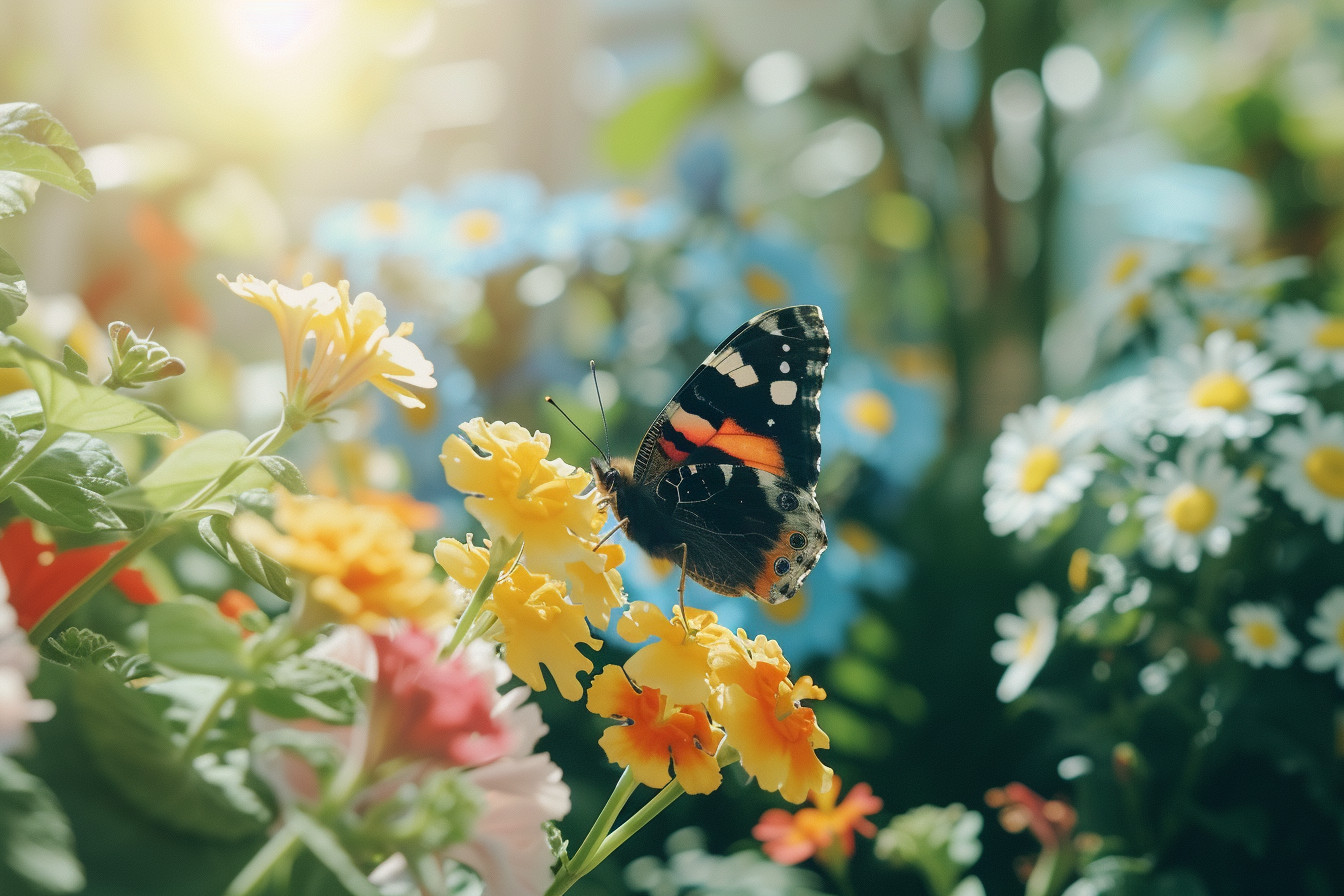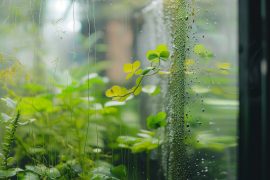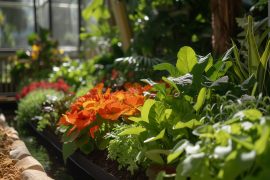I’ve always had a soft spot for those little buzzers and flutters that visit my garden. It’s not just the splash of color they bring or their gentle dance from flower to flower; it’s knowing I’m providing a sanctuary in my own small way. Turning vertical surfaces into lush havens isn’t new, but doing so with an eye towards attracting pollinators like bees and butterflies? Now that’s something special.
Creating these living works of art doesn’t require acres of land or hours upon hours on your knees in the dirt—vertical gardening is all about making use of what you’ve got, whether it be fences, walls, or even balcony railings. With some planning and creativity, we can transform underused spaces into thriving ecosystems buzzing with life while also decking out our outdoor (or indoor) space stylishly.
And let me tell you, maintaining them brings its own unique joy beyond watching them grow—it’s incredibly calming, almost meditative, across seasons as fresh faces appear amongst blooms, ready to feast on nectarine banquets laid out specially for them.
My mornings often involve sipping coffee accompanied by serene views punctuated by hovering wings, sharp dives, undulating flight patterns, and creating moments of ironically full energy and immeasurably peaceful at once. Each encounter serves as a reminder of the interconnectedness between us, winged guests, and abode sharing that ensures sustenance and mutual flourishing.
The Importance of Pollinators
Let’s dive right in and talk about the real MVPs of our gardens: pollinators. When I first started gardening, my focus was all on what I could see above ground. It wasn’t long before I realized that much of the magic happens thanks to these tiny workers we often overlook.
Pollinators include a diverse group, ranging from bees and butterflies to birds, bats, and even some small mammals. Each plays a crucial role in transferring pollen from one flower to another, facilitating not just beautiful blossoms but also fruit production for plants reliant on cross-pollination.
To give you an idea:
- Bees are like the gardeners’ best friends; they’re responsible for pollinating many crops, including apples and almonds—basically, lots of stuff we love.
- Butterflies, with their preference for bright flowers and unique flight patterns, help cross-pollinate easily as well!
Their work doesn’t stop at making sure your favorite fruits appear every season or keeping flowers blooming beautifully throughout spring and summer—it goes way beyond that, creating ecosystems supportive of both plant diversity and biodiversity, which is essential to maintaining balance within nature itself.
Here’s something thought-provoking: It’s estimated that nearly 1/3 of the global food supply depends solely on these diligent creatures. Without them, there’d be a significant impact on not only the availability of certain foods but also the overall health environment. Such symbiotic relationships thrive.
Aside from playing pivotal roles in ensuring sustenance throughout the entire planet, inhabitants engaging in vertical gardening practices specifically designed to attract a wide variety can greatly enhance any space, turning it into a sanctuary of calm connection, deeper understanding, and delicate interconnectedness.
By incorporating native species walls, green roofs, and other structures, we can recreate habitats lost due to urban expansion efforts, which contribute significantly to the preservation of vital agents and reproduction.
Moreover, experiencing joy watching flutter around vibrant colors and taking a moment to appreciate silence Broken-winged visitors add unmatched tranquility. Serenity, a personal oasis
Why attract bees and butterflies?
Ever wondered why gardeners are so keen on attracting bees and butterflies to their spaces? Let me tell you, it’s not just about the beauty of having these fluttering friends around. These creatures play a crucial role in our ecosystem, especially when it comes to pollination.
Bees, known as nature’s workaholics, are pivotal for pollinating many plants we rely on for food. Without them buzzing from flower to flower, transferring pollen necessary for plant reproduction—let’s face it—some crops would struggle severely or fail altogether. Consider this: Approximately one-third of the food humans consume is courtesy of bee-pollinated plants. That puts things into perspective, right?
Butterflies aren’t slackers either when contributing to ecological balance! Besides adding aesthetic value with their graceful presence, they’re involved in helping plant populations spread out by carrying pollen over greater distances than most other insects can achieve.
We’ve got numbers supporting how vital these critters are:
| Pollinator | Approximate Percentage Contribution |
|---|---|
| Honeybees | 80% |
| Other bee species | 12% |
Choosing the Right Plants
When I first dipped my toes into vertical gardening for pollinators, I realized it wasn’t just about stacking up some plants and hoping for the best. It’s more akin to painting a living masterpiece that requires thought, care, and, most importantly, selecting the right palette of plants. Here are a few pointers to help you create a buzzing haven in your own garden.
Prioritize Native Species
Nothing invites bees and butterflies like native plants do. They’re essentially nature’s golden ticket, attracting these beneficial insects effortlessly due to their long-standing relationship with local wildlife.
- Milkweed is fantastic for monarch butterflies.
- Bees often buzz around purple coneflowers.
Why go native? Simple: they’re well-adapted to our soil and climate—and our little flying friends recognize them immediately as home sweet home.
A burst of colors attracts more pollinators.
Pollinators love bright colors like blues, purples, and reds, but each species has its own preferences.
| Flower | Color preferred by |
|---|---|
| Lavender | Purple (Bees) |
| Zinnia | Various (butterflies and bees) |
Adding variety not only makes your garden visually stunning but also welcomes diverse guests.
Sunlight is key.
Remember, sunlight matters as much as plant choice does! A majority of flowering beauties thrive under full sun, inviting those precious pollinating moments exactly where needed—right among your beautiful blooms!
Designing Your Vertical Garden for Pollinators
Designing a vertical garden that’s a beacon for pollinators such as bees and butterflies isn’t just about making your space beautiful. It’s also about creating an environment where these crucial creatures can thrive.
Let’s dive into how you can achieve this through thoughtful plant selection, understanding the needs of local pollinator species, and incorporating features that cater specifically to their requirements.
Choosing the Right Plants: This step is key to attracting those buzzy visitors we all love to see darting around our gardens. Aim for diversity in the plants you select; include varieties known to attract bees and butterflies, both with nectar-rich flowers such as lavender, foxglove, salvia, catmint, bee balm, snapdragon, and black-eyed Susan sunflower dahlias Butterfly bush (Buddleia).
These provide essential food sources throughout different times of the year, helping to ensure there are always blooms available when pollinators visit.
- Nesting Opportunities: Creating nesting sites within your vertical design makes it irresistibly inviting! Bees especially benefit from having materials like small branches, hollow reeds, or even blocks of wood with holes drilled into them incorporated among flowering plants, offering places to rest and reproduce without venturing far from sustenance.
Tips for Maintaining a Pollinator-Friendly Vertical Garden
Creating and maintaining a vertical garden that’s inviting to pollinators such as bees and butterflies is more than just aesthetically pleasing—it forms an essential part of urban biodiversity. Here are some practical tips on how you can ensure your vertical oasis remains buzzing with life.
Choose the Right Plants: First things first, the selection of plants plays a crucial role in attracting pollinators. Aim for native species since they’re like comfort food for local wildlife; it’s what they know best! Include flowering varieties that bloom at different times throughout the year, ensuring there’s always something to offer our winged friends.
Think about adding lavender, sage, or even oregano—a nice mix ensures variety not only visually but also functionally.
- Lavender: Beloved by bees
- Sage attracts both bees and butterflies.
- Oregano offers nectar-rich blooms.
By picking these types, you’ll be helping out many types of pollinators while making sure your garden stays vibrant across the seasons.
Provide Water Sources: Just like us after some good exercise (think marathon flying from flower to flower), insects need hydration too! Incorporating small, shallow dishes among your greens will keep them hydrated, especially during those scorching summer days we all dread slightly but secretly enjoy because, hey, more sun means more flowers, right?
Make sure water sources are shallow enough so delicate insect visitors won’t drown trying to take a sip—the depth should be no more than one inch with stones placed inside, allowing them easy access without risk.
Avoid pesticides completely.
It goes without saying pesticides aren’t anyone’s friend here—they wreak havoc on helpful bug populations, including voracious predators keeping potential plant pests under control.
Instead, get down into Mother Nature mode, opting for natural pest management strategies:
- Introducing beneficial bugs, e.g., ladybugs who love munching aphids away;
- Using neem oil-based sprays sparingly where absolutely necessary, focusing heavily on infested areas, and avoiding wide-spread application;
This way, harm towards non-target organisms, particularly critical pollen movers, gets drastically minimized, letting nature play its magical balance game almost undisturbed.
Final Thought
So we’ve journeyed through the ins and outs of vertical gardening for pollinators, where bees buzz around with purpose and butterflies add a splash of color to our green spaces. It’s clear by now how vital these creatures are, not only for our gardens but for sustaining life on this planet as vibrant as it is.
I’ve shared my own little adventures with you—turning bland walls into thriving habitats, choosing plants that seem like magnets to these tiny workers, and witnessing the transformation first-hand.
I mean, who knew a few well-placed flowers could make such a difference? But here’s what sticks: every flower planted is a step towards a healthier ecosystem. And honestly, there’s something incredibly peaceful about watching nature do its thing right in your backyard or balcony.
This whole experience has been more than just planting; it’s been educational too! Who’d have thought I’d become so engrossed in learning which blooms attract which pollinator? Or that certain colors would be equivalent to putting out an all-you-can-eat buffet sign?
Here are some bullet points because, let’s face it, everyone loves bullet points:
- Select Plants Carefully: Go for native species whenever possible since they’re already adapted to your local climate and beloved by local wildlife.
- Water wisely: Even though vertical gardens usually require less water, beware that over-watering can still happen!
- Think About Heights: Layer different types of plants according to their heights, maximizing space without overshadowing smaller ones.
Stepping back and looking at my once-plain wall now cascading down with greens, yellows, and pinks, it hits me. These aren’t just random assortments. They represent connections. A bridge between urban living and wild marvels






